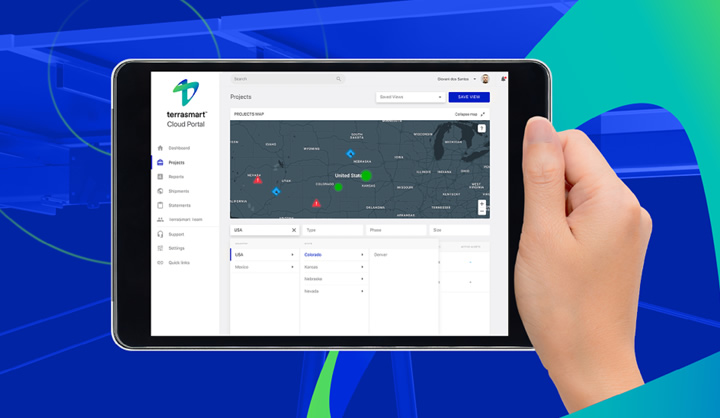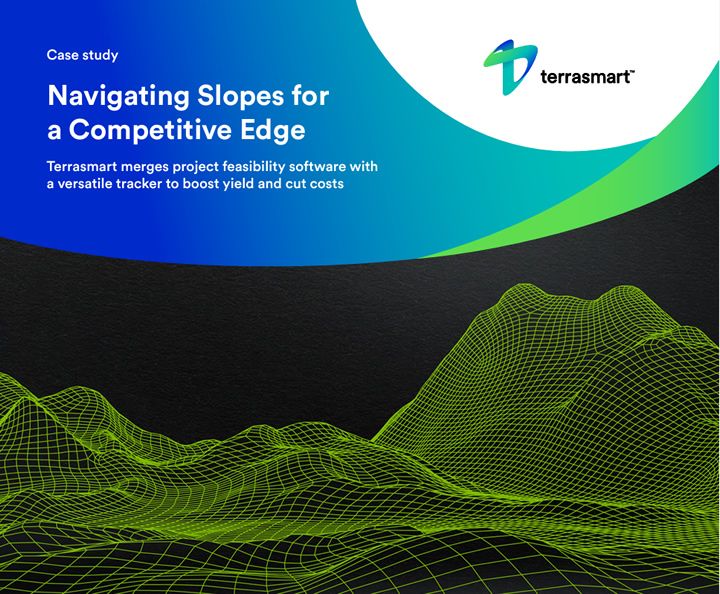Terrasmart design engineers use SIFT to help developers and EPCs bring in system design, performance, and financial modeling early in the project cycle. SIFT helps them identify the right racking system and optimize the layout to increase energy yield, returns, and value.
Case Study | Terrasmart
SIFT through options to streamline from the start
Traditionally, site assessment involves contracting third-party civil engineers to perform granular topographical analyses on-site. This time- and resource-intensive manual process can bog down progress at the start. And, even after it’s complete, revisions may be required to determine a suitable site plan. Oftentimes, developers consider multiple plots of land and hire engineers to evaluate all scenarios, which is neither cost effective or practical.
But now there are smarter, faster ways to analyze a site’s topography. Terrasmart’s Solar Instant Feasibility Tool, or SIFT, can streamline slope analysis, and optimize site design from the start. With a proven track record, SIFT has already been applied to 250 GWs of potential capacity, helping developers and asset owners extract from 5% to 15% higher returns on their projects by rapidly simulating thousands of different layouts in minutes.
Today, Terrasmart design engineers use SIFT to help developers and EPCs bring in system design, performance, and financial modeling early in the project cycle. SIFT helps them identify the right racking system and optimize the layout to increase energy yield, returns, and value.
SIFT is a powerful tool that helps optimize components, construction, and system performance. It can iterate through multiple cost/benefit scenarios to analyze racks with varying slope flexibility and evaluate their impact on construction costs. For example, SIFT is used to understand when a 2P tracker versus a 1P tracker are needed to maximize production or minimize land grading and keep construction on track.
Designed for speed, cloud based SIFT models hundreds of layouts, conditions, performance goals, and financial scenarios in seconds. Users can optimize configurations and components, import their own module and inverter data from multiple industry databases, and run IRR and LCOE models.
Instead of running multiple manual iterations, Terrasmart system engineers use SIFT to shave weeks off design work, analyzing hundreds of project layouts, conditions, performance goals, and financial scenarios in minutes.

SIFT generated heat map of hundreds of layout configurations, representing the trade-off between the row spacing (GCR), DC:AC ratio and rate of return (IRR%).
Terrasmart uncovers hidden value with SIFT’s site-optimization features, including:
- Creating accurate topography and slope analysis layers using USGS.
- Deploying gold-standard layout and performance tools to make optimal design choices and product selections.
- Generating a heat map of various elevation points to enhance overall understanding of the site’s potential.
- Ensuring seamless import and export of industry standard data including importation of KMZ, PAN and OND f iles and exportation of PDF, CAD and SHD files

Using SIFT is much faster and much cheaper. SIFT helps our designers tweak things on the fly and run different scenarios without asking the third-party civil engineers to go back and look again or take a different angle.” — Jake Bartosch, Terrasmart SIFT Sales Manager
Reducing grading and civil costs with SIFT
It’s critical to understand quickly what the different impacts are between trackers that allow for 10%, 15%, or 20% slope tolerances. That’s why Terrasmart uses SIFT to analyze how a site’s topography will alter project costs and production yield.
Using elevation data from USGS, SIFT quickly identifies areas that require grading, given a rack’s slope tolerance. Heat maps show where racks can be installed for any given cut-and-fill parameter and can update the map by changing a rack’s tolerance in seconds.
Any SIFT user can load average local and regional labor costs into the tool to help calculate site-specific budgets for moving each cubic yard of earth. For example, developers and EPCs can set a target of a maximum 15% grade for the entire site, prompting SIFT to determine how much earth needs to be moved — and how much that likely will cost.
Combining smart software and hardware ensures peak production
Terrasmart combines feasibility software with a flexible tracking system to deliver unique production advantages.
First, SIFT takes an undulating site’s many possible grading scenarios into account to determine how elevation impacts shading and energy production. The tool generates energy production data for any given row spacing and determines shade impact based on any terrain profile.
Running scenarios with varying row spacing, shade impact, slope, and tracker tolerances allows Terrasmart to educate a developer on the myriad possibilities. “It’s no longer just a rule of thumb on row spacing, but rather a sophisticated model that synthesizes all of the variables to help get a better picture,” Bartosch says.
Adding Terrasmart’s new TerraTrak 2P solution to the mix adds valuable flexibility to the equation, helping developers turn even the most hilly sites into viable projects. Its unique pairing of an adaptable A-frame structure and ground screw foundations can accommodate up to 20% N/S slopes and unlimited E/W slopes. Telescoping screw extensions deliver best-in-class vertical adjustability of up to 36 inches to overcome undulating topography, significantly reducing grading requirements. TerraTrak 2P’s plus-or-minus 60-degree range of motion streamlines installations on even the steepest slopes.
While most other trackers on the market can accommodate a 10% or 15% slope, our A-frame and screw foundation can be put on the worst parts of a site. We can pack in more trackers to boost yields while lowering risks, which increases site potential and project ROI.” — Brian Martin, Terrasmart’s Tracker Project Engineering Manager

Intelligent tracking optimizes energy yield
To produce more energy, the tracker’s PeakYieldTM software uses adaptive machine learning and historical data to optimize module positions and gain maximum energy yield. PeakYield’s proprietary backtracking algorithm minimizes row-to-row shading through analyzing tracking status, angle, and shade from neighboring rows, communicating the assessment wirelessly in real-time to the on-site network controller.
Proving the advantage:
Maine projects showcase client wins
Two projects in Maine showcase how critical topography considerations can be to both increasing energy production and lowering costs. The Rumford project highlights production and yield advantages, while the Jay Solar system shows how reduced grading can result in substantial installation savings.
In both cases the TerraTrak projects are compared to two alternative trackers, Tracker 2 with a 15% grade tolerance and Tracker 3 with a 10% grade tolerance. All three tracker scenarios include a 60-degree tracker angle.

Rumford Solar Project: Production Yield Advantages
The 6.5-MW Rumford site features precipitous slopes throughout its rocky Maine landscape. But with its leading 20% grade tolerance and positioning using SIFT on south-facing slopes, TerraTrak 2P has been able to generate 4.3% more energy than Tracker 2 and 4.7% more than Tracker 1 (see TerraTrak yield advantage over alternative trackers below).
Looking at the various parameters pertaining to yield, TerraTrak’s advantage in the “no-grade capacity” metric stands out. For this site, TerraTrak delivers a 7.1-MW capacity potential without grading, while the other options offer 5.9 MWs and 4.6 MWs without grading.
.jpg)
Jay Solar Project: Less grading equals maximum savings
The 7-MW Jay site also presented slope challenges that would have required substantial civil work had the EPC selected Tracker 2 or 3 rather than TerraTrak 2P. In this scenario, TerraTrak’s slope adaptability resulted in 90% to 99% less grading than the alternatives. On this site, a 15% grade tolerance would require moving 25,227 cubic yards of earth; a 10% grade tolerance would have required eight times that amount — 205,932 cubic yards. With TerraTrak 2P, the EPC and its contractors only had to move 1,545 cubic yards of soil.
At an estimated cost of $30 per yard to cut and $20 per yard to fill on this site, TerraTrak delivered huge cost savings to the EPC, the developer, and the asset owner: $567,000 less than Tracker 2, or an $0.08/ Wp difference. Compared to Tracker 3, TerraTrak’s cost saving is an astounding $5.1 million in avoided grading costs, or a $0.08/ Wp cost difference.
Our clients understand that they might have slightly higher up-front material costs with TerraTrak, but when they take into account grading and installation, they can save a lot of money in the long run with our full package. With hilly sites, those grading costs can get really expensive, especially as the sites get larger, resulting in potentially millions of dollars in expense.” — Andrea Oliver, Terrasmart Senior Product Marketing Manager
The content & opinions in this article are the author’s and do not necessarily represent the views of AltEnergyMag

Terrasmart
Terrasmart, the renewable energy portfolio of Gibraltar (NASDAQ: ROCK), is a leading provider of solar racking technologies, electrical balance-of-system products, installation services, and project optimization software. Harnessing the combined strengths, technical expertise, and heritage of its four legacy brands, Terrasmart delivers a holistic project experience providing leading solar technologies and smart solutions across the project lifecycle to mitigate risks and amplify returns for solar projects of any size, type, and location. Serving the commercial, DG and utility sectors across North America, Terrasmart integrates products and solutions across the PV lifecycle to minimize risks and maximize returns. With over 24 GWs of solar deployed across 6,000 PV systems, Terrasmart creates unique value for more profitable solar on any terrain, anywhere in the U.S.
Other Articles
Terrasmart Launches In-House Ground Screw Production for Solar Sites
ADVANCING A SAFETY-FIRST SOLAR CULTURE
A Foundation for Success: Navigating Bedrock & 180-mph Winds
More about Terrasmart
Comments (0)
This post does not have any comments. Be the first to leave a comment below.
Featured Product


